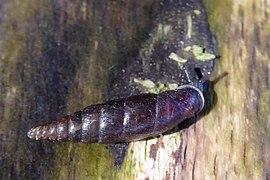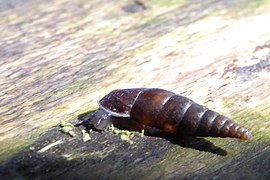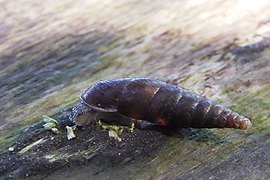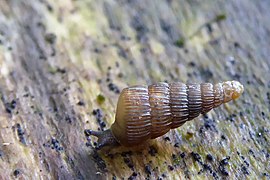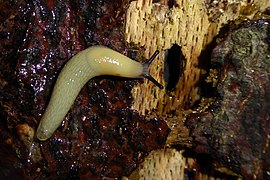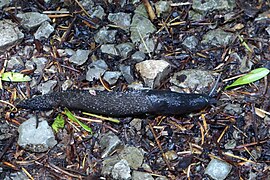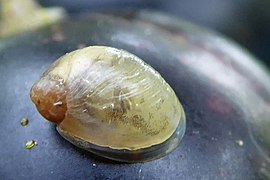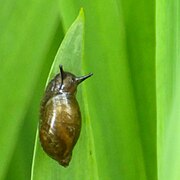User talk:Kryp
Herzlichen Dank[edit]
für das Bestimmen und Kategorisieren meiner Nacktschneckenbilder und der vieler anderer Schneckenunkundiger. Auch wenn ich in diesem Zusammenhang fast mit Bedauern feststelle, dass die Spanische Wegschnecke es doch bis auf die Nordseeinsel Juist geschafft hat - vielleicht gelingt es ihr aber dort nicht, die Rote Wegschnecke zu verdrängen. Herzliche Grüße, --4028mdk09 (talk) 11:44, 4 June 2011 (UTC)
Hallo Francisco, vielen Dank für die Bestimmung. Gruß --Hedwig Storch (talk) 11:55, 4 June 2011 (UTC)
I need help[edit]
Hi FranciscoWelterSchultes,
I have some pictures with molluscs, but I don't know what species are. Perhaps you may know.
-
Cypraea moneta
-
Cypraea moneta
Thanks. DenesFeri (talk) 15:23, 9 June 2011 (UTC)
- I need to know the localities where the specimens were from. I am not a specialist for marine shells, but I could try something with the non-marine species. -- FranciscoWelterSchultes (talk) 16:54, 9 June 2011 (UTC)
The non-marine species are from London and the WWT London Wetland Center. The marine species are from a shop from Isle of Wight, South England. Probably they were colected from the waters of that island. Do you know a marine mollusc expert here in commons? DenesFeri (talk) 08:02, 10 June 2011 (UTC)
- The species from the shop are imported species, from exotic countries and not from England. Salesmen buy them in large quantities on the fish market in Dar es Salaam or Manila. It would be necessary to know the localities. London for the others is good. -- FranciscoWelterSchultes (talk) 16:51, 10 June 2011 (UTC)
Hi FranciscoWelterSchultes,
Thank you wery much for your help! I do not know from where the salesmen buy the marine molluscs. That remains a mistery. DenesFeri (talk) 09:32, 11 June 2011 (UTC)
Other pictures[edit]
Hi,
I have three pictures with snails. I tried to identify them, but I'm not sure. Perhaps you may recognize them.
Thanks. DenesFeri (talk) 09:49, 12 July 2011 (UTC)
Hi FranciscoWelterSchultes,
Could you help me with those three pictures? DenesFeri (talk) 10:46, 14 July 2011 (UTC)
- Should be Cepaea nemoralis, a frequent species in England. -- FranciscoWelterSchultes (talk) 16:35, 25 July 2011 (UTC)
All of them? DenesFeri (talk) 08:12, 26 July 2011 (UTC)
- 2 and 3 are the same, I thought also 1 was the same. If not, then 1 could also be Cepaea hortensis. -- FranciscoWelterSchultes (talk) 09:33, 26 July 2011 (UTC)
2 and 3 are from july 7 and 1 is from july 5, so probably they are two different snails. 1 could be C. hortensis? DenesFeri (talk) 09:43, 26 July 2011 (UTC)
- 1 could be both, yes. The photo is of a bad quality and does not show the aperture. -- FranciscoWelterSchultes (talk) 09:52, 26 July 2011 (UTC)
OK, Thank you! DenesFeri (talk) 10:12, 26 July 2011 (UTC)
Tip: Categorizing images[edit]
Thanks a lot for contributing to the Wikimedia Commons! Here's a tip to make your uploads more useful: Why not add some categories to describe them? This will help more people to find and use them.
Here's how:
1) If you're using the UploadWizard, you can add categories to each file when you describe it. Just click "more options" for the file and add the categories which make sense:
2) You can also pick the file from your list of uploads, edit the file description page, and manually add the category code at the end of the page.
[[Category:Category name]]
For example, if you are uploading a diagram showing the orbits of comets, you add the following code:
[[Category:Astronomical diagrams]][[Category:Comets]]
This will make the diagram show up in the categories "Astronomical diagrams" and "Comets".
When picking categories, try to choose a specific category ("Astronomical diagrams") over a generic one ("Illustrations").
Thanks again for your uploads! More information about categorization can be found in Commons:Categories, and don't hesitate to leave a note on the help desk.CategorizationBot (talk) 14:16, 10 October 2011 (UTC)
- Image:Caelifera-7720r.JPG was uncategorized on 9 October 2011 CategorizationBot (talk) 14:16, 10 October 2011 (UTC)
- Image:Caelifera-7843r.JPG was uncategorized on 9 October 2011 CategorizationBot (talk) 14:16, 10 October 2011 (UTC)
- Image:Caelifera-8597r.JPG was uncategorized on 9 October 2011 CategorizationBot (talk) 14:16, 10 October 2011 (UTC)
- Image:Caelifera-8607r.JPG was uncategorized on 9 October 2011 CategorizationBot (talk) 14:16, 10 October 2011 (UTC)
- Image:Caelifera-8262r.JPG was uncategorized on 9 October 2011 CategorizationBot (talk) 14:16, 10 October 2011 (UTC)
- Image:Caelifera-8308r.JPG was uncategorized on 9 October 2011 CategorizationBot (talk) 14:16, 10 October 2011 (UTC)
- Image:Caelifera-8303r.JPG was uncategorized on 9 October 2011 CategorizationBot (talk) 14:16, 10 October 2011 (UTC)
- Image:Caelifera-8269r.JPG was uncategorized on 9 October 2011 CategorizationBot (talk) 14:16, 10 October 2011 (UTC)
- Image:Caelifera-8820r.JPG was uncategorized on 9 October 2011 CategorizationBot (talk) 14:16, 10 October 2011 (UTC)
- Image:Caelifera-8755r.JPG was uncategorized on 9 October 2011 CategorizationBot (talk) 14:16, 10 October 2011 (UTC)
- Image:Caelifera-8630r.JPG was uncategorized on 9 October 2011 CategorizationBot (talk) 14:16, 10 October 2011 (UTC)
- Image:Caelifera-8389r.JPG was uncategorized on 9 October 2011 CategorizationBot (talk) 14:16, 10 October 2011 (UTC)
- Image:Caelifera-8711r.JPG was uncategorized on 9 October 2011 CategorizationBot (talk) 14:16, 10 October 2011 (UTC)
- Image:Caelifera-8770r.JPG was uncategorized on 9 October 2011 CategorizationBot (talk) 14:16, 10 October 2011 (UTC)
- Image:Caelifera-7891r.JPG was uncategorized on 9 October 2011 CategorizationBot (talk) 14:16, 10 October 2011 (UTC)
- Image:Caelifera-7875r.JPG was uncategorized on 9 October 2011 CategorizationBot (talk) 14:16, 10 October 2011 (UTC)
- Image:Caelifera-8012r.JPG was uncategorized on 9 October 2011 CategorizationBot (talk) 14:16, 10 October 2011 (UTC)
- Image:Caelifera-8294r.JPG was uncategorized on 9 October 2011 CategorizationBot (talk) 14:16, 10 October 2011 (UTC)
- Image:Caelifera-8804r.JPG was uncategorized on 9 October 2011 CategorizationBot (talk) 14:16, 10 October 2011 (UTC)
Fremdbilder[edit]
Hallo FranciscoWelterSchultes,
wenn du Bilder anderer Urheber hochlädst (wie die Libellenbilder der Urheberin Christina Appel), solltest du dokumentieren, dass du berechtigt bist, diese Bilder hier hochzuladen und unter eine freie Lizenz zu stellen. Das geht per E-Mail, Details siehe Commons:OTRS/de. Wenn du das nicht machst, können die Bilder wieder gelöscht werden, da wir nicht sicher sein können, ob das so genehmigt ist. Viele Grüße --Rosenzweig τ 22:32, 14 September 2013 (UTC)
- Schritt 1 war okay, ich hab die Genehmigung der Urheberin per mail. Der Rest klingt sehr zeitaufwendig. Wahrscheinlich wäre es die naheliegendere und einfachere Option, wenn ich mir das sparen will, wenn die Bilder wieder gelöscht werden. -- FranciscoWelterSchultes (talk) 23:31, 14 September 2013 (UTC)
- Ich habe dir dazu was auf deine Diskussionsseite in der de.wp geschrieben. Evtl. kannst du die Mail der Urheberin ans OTRS weiterleiten (wenn sie nichts gegen das Weiterleiten hat), frag die OTRS-Leute mal. Gruß --Rosenzweig τ 13:09, 15 September 2013 (UTC)
Copyright status: File:Ampel-Goettingen-19.jpg[edit]
No required license templates were detected at this file page. Please correct it, or if you have any questions please contact me on my talk page. Yours sincerely, Jarekt (talk) 16:47, 8 January 2014 (UTC)
- I added the license. It was a technical problem, my initial license information was not captured, I did not understand why. -- FranciscoWelterSchultes (talk) 18:04, 8 January 2014 (UTC)
Autopatrol given[edit]

Hello. I just wanted to let you know that I have granted autopatrol rights to your account; the reason for this is that I believe you are sufficiently trustworthy and experienced to have your contributions automatically marked as "reviewed". This has no effect on your editing, it is simply intended to make it easier for users that are monitoring Recent changes or Recent uploads to find unproductive edits amidst the productive ones like yours. In addition, the Flickr upload feature and an increased number of batch-uploads in UploadWizard, uploading of freely licensed MP3 files, overwriting files uploaded by others and an increased limit for page renames per minute are now available to you. Thank you. INeverCry 01:37, 17 March 2014 (UTC)
Bitte nicht überkategorisieren[edit]
Hallo FranciscoWelterSchultes, bitte überkategorisiere Deine Bilder nicht. Beispiel: File:Ampel-Goettingen-42a.jpg
- Category:Traffic signals in Göttingen ist völlig i.O., wenn Du das Bild in Göttingen gemacht hast.
- Category:Traffic signals in Germany ist als zusätzliche Kategorie falsch, denn es ist eine Elternkategorie von Category:Traffic signals in Göttingen.
Das Problem der Überkategorisierung ist hier noch einmal deutlich erklärt: Commons:Categories. Gruß, -- Ies (talk) 16:16, 29 July 2014 (UTC)
- Danke für den Hinweis. Bei den Ampel-Kategorien hatte ich lange Zeit Probleme, die waren sehr unübersichtlich und ich habe lange gesucht, bis ich Bilder zu einem bestimmten Thema gefunden habe. -- FranciscoWelterSchultes (talk) 10:08, 30 July 2014 (UTC)
Hallo Kryp, war das jetzt umbedingt nötig wegen einem Bild eine Category zu erstellen??? Im Übrigen gehören Kategorien von Gewässern von Hannover in Category:Bodies of water in Hannover oder bei z.B. Bächen, Teichen (Streams, Ponds) noch eins drunter, diese ist leicht zufinden über Category:Geography of Hannover, da diese unter Category:Hannover eingeordnet ist. Gruß --Jean11 (talk) 16:46, 20 November 2014 (UTC)
- Ja, war nötig. Ich habe das einheitlich so gemacht, jeder See in Niedersachsen hat eine eigene Category bekommen. Mindestanzahl natürlich 1 Bild, aber da können ja jederzeit welche dazukommen (und erfahrungsgemäß kommen da auch immer mehr dazu).
- In Wikipedia gibt es dann auch immer eine entsprechende Seite für den See bzw. die wird nach und nach angelegt (Sonnensee derzeit noch nicht, aber ich hab bei A angefangen und bin erst bei E). Für diesen Arbeitsschritt ist es wichtig zu wissen, wenn keine entsprechende Commons-Category existiert. Dann kann man sicher sein, es gibt kein Bild und man braucht nicht stundenlang irgendwo rumsuchen.
- Es war ausserdem gerade in diesem Fall eine ziemlich lange Arbeit, überhaupt rauszukriegen, dass das der Sonnensee war, der da auf der Luftaufnahme drauf war. Das war extrem sinnvoll, die Kategorie einzurichten, weil ohne diese Kategorie wüsste niemand, dass ein freies Bild vom Sonnensee im Internet existiert.
- Zu den Kategorien von Gewässern: die sind in jedem Landkreis anders, da hab ich keinen Überblick. Ich habe immer nur die "Category:Lakes in..."-Katergorie eingetragen (weil die ist einheitlich bei jedem See in jedem Landkreis drin, so kann man unter Category:Lakes of Lower Saxony alle Seen in Niedersachsen gesammelt finden), und dann meist noch den jeweiligen Ort. Du kannst da gerne jederzeit weitere sinnvolle Kategorien dazuschreiben. Bei WP ist genau dasselbe Problem, da gibt es Leute, die da einen viel besseren Überblick haben als ich und das mit dem katfix dann hinterher machen. Gruss -- Kryp (talk) 20:08, 20 November 2014 (UTC)
Copyright status: File:Gradierwerk-Bad-Sooden-03.jpg[edit]
No required license templates were detected at this file page. Please correct it, or if you have any questions please check my FAQ or contact me on my talk page. Yours sincerely, Jarekt (talk) 12:04, 13 May 2015 (UTC)
- I had overlooked to select that, thanks. -- Kryp (talk) 13:30, 13 May 2015 (UTC)
Bergsee Haje[edit]
Hallo Francisco, Du kennst Dich doch mit den Seen in der südniedersächsisch-nordhessischen Region aus. Habe eben vergeblich auf Commons ein Bild vom Bergsee bei Haje / Delliehausen gesucht. Meine eigenen sind nicht so dolle, es war halt noch alles kahl, als ich da fotografiert habe. Weißt Du, ob es bessere gibt? Oder hast Du welche, die Du sowieso gerade hochladen woltest? Sonst kann ich auch erst mal eins von meinen kahl aussehenden hochladen für die Liste der Naturdenkmale. --Dehio (talk) 12:52, 27 May 2016 (UTC)
- Von diesem See hab ich kein Bild. Nur vom Mecklenbruch bei Silberborn und vom Naturschwimmbad bei Schönhagen. Dann nimm mal deine, ist besser als nichts. Gruss -- Kryp (talk) 13:04, 27 May 2016 (UTC)
- Ok, danke. Wenn ich mal wieder hinkomme (oder Du), gibt es vielleicht bessere. --Dehio (talk) 13:10, 27 May 2016 (UTC)
[edit]
Hello! The Wikimedia Foundation is asking for your feedback in a survey. We want to know how well we are supporting your work on and off wiki, and how we can change or improve things in the future.[survey 1] The opinions you share will directly affect the current and future work of the Wikimedia Foundation. You have been randomly selected to take this survey as we would like to hear from your Wikimedia community. To say thank you for your time, we are giving away 20 Wikimedia T-shirts to randomly selected people who take the survey.[survey 2] The survey is available in various languages and will take between 20 and 40 minutes.
You can find more information about this project. This survey is hosted by a third-party service and governed by this privacy statement. Please visit our frequently asked questions page to find more information about this survey. If you need additional help, or if you wish to opt-out of future communications about this survey, send an email to surveys@wikimedia.org.
Thank you! --EGalvez (WMF) (talk) 20:05, 13 January 2017 (UTC)
- ↑ This survey is primarily meant to get feedback on the Wikimedia Foundation's current work, not long-term strategy.
- ↑ Legal stuff: No purchase necessary. Must be the age of majority to participate. Sponsored by the Wikimedia Foundation located at 149 New Montgomery, San Francisco, CA, USA, 94105. Ends January 31, 2017. Void where prohibited. Click here for contest rules.
Your feedback matters: Final reminder to take the global Wikimedia survey[edit]
(Sorry to write in Engilsh)
Hello! This is a final reminder that the Wikimedia Foundation survey will close on 28 February, 2017 (23:59 UTC). The survey is available in various languages and will take between 20 and 40 minutes. Take the survey now.
If you already took the survey - thank you! We won't bother you again.
About this survey: You can find more information about this project here or you can read the frequently asked questions. This survey is hosted by a third-party service and governed by this privacy statement. If you need additional help, or if you wish to opt-out of future communications about this survey, send an email through EmailUser function to User:EGalvez (WMF) or surveys@wikimedia.org. About the Wikimedia Foundation: The Wikimedia Foundation supports you by working on the software and technology to keep the sites fast, secure, and accessible, as well as supports Wikimedia programs and initiatives to expand access and support free knowledge globally. Thank you! --EGalvez (WMF) (talk) 07:57, 24 February 2017 (UTC)
I have used one of your photos[edit]
Hello Kryp!
I have used a photo of Laphria flava in my free software educational proyect "Animalandia" (http://animalandia.educa.madrid.org)
You can see directly in the follow link and clic over "Siguiente" ("Next") several times:
http://animalandia.educa.madrid.org/imagen.php?id=46441
If you wish (and I hope yes), you can send me (via fernando.lison@educa.madrid.org) some letters or/and a photo for your "contributor profile" in Animalandia:
http://animalandia.educa.madrid.org/autor.php?nombre=Kryp
I want show to my students (and so everybody) that Animalandia is make for "real person", and I can tell them about "generosity", "share" and other similar words that we use very few at this time...
This is my "contributor profile" and others, for example:
http://animalandia.educa.madrid.org/autor.php?nombre=Fernando%20Lis%F3n%20Mart%EDn
http://animalandia.educa.madrid.org/autor.php?nombre=Carmen%20Jim%E9nez
http://animalandia.educa.madrid.org/autor.php?nombre=David%20P%E9rez
http://animalandia.educa.madrid.org/autor.php?nombre=Steve%20Garvie%20%28Rainbirder%29
In the future, I use more of your photos, I sure!
Thank you for the licence and, of course, for your splendid photos!!
Regards!
Fernando Lisón, from Spain --Fernando.lison (talk) 15:46, 16 June 2017 (UTC)
- Gracias para alertarme, y tenga mi gran respecto para este sitio. Puedes también hallar fotos a www.animalbase.de, se pueden usar todas las fotos que son mias. Saludos - Francisco --Kryp (talk) 22:08, 16 June 2017 (UTC)
- ¡Muchas gracias Francisco! ¿Cómo encuentro tus imágenes en http://www.animalbase.de/? --Fernando.lison (talk) 10:48, 17 June 2017 (UTC)
- Hay varios caminos para llegar a los imágenes. Puedes ir aquí: "All taxa alphabetically", y buscar "Taxon begins with" por una especie (insertar FLAV, pero son muchísimos resultados) o un género (insertar LAP), entonces escoger "Laphria", pues scrolar abajo y clicar "Species in Laphria [n = 1]", ahí clicar a la foto del bicho y ves más fotos. Buscando por la especies llegas más rápido a los imágenes, pero hay varios caminos. Puedes tambien ir allá: "List of all thumbnails [n=16952"] y llegas a miles de fotos. Son casi todas libres, sobretodo los míos y los de Raymond Huet, Panayotis Ovalis y otros. Saludos - Francisco --Kryp (talk) 11:53, 17 June 2017 (UTC)
- ¡Gracias! ¿No se puede llegar a todas tus fotos a la vez, verdad? Buscaré cuando necesite alguna especie en particular. Otra cosa: ¿Dejo en Animalandia como nombre Kryp o pongo Francisco Welter Schultes? — Preceding unsigned comment added by Fernando.lison (talk • contribs) 13:54, 17 June 2017 (UTC)
- Puedes poner Francisco Welter-Schultes. Valdría también Kryp, igual, pero veo que la mayoría de tus colaboradores en el listado se indican con nombres proprios. Te he mandado una foto por correo electrónico. --Kryp (talk) 15:31, 17 June 2017 (UTC)

|
File:Wahlplakattafel-58-Goettingen2014.jpg has been listed at Commons:Deletion requests so that the community can discuss whether it should be kept or not. We would appreciate it if you could go to voice your opinion about this at its entry.
If you created this file, please note that the fact that it has been proposed for deletion does not necessarily mean that we do not value your kind contribution. It simply means that one person believes that there is some specific problem with it, such as a copyright issue. Please see Commons:But it's my own work! for a guide on how to address these issues. |
hilarmont \\ talk, talk, talk 22:14, 20 September 2017 (UTC)
- The picture should be protected by both the freedom of press and the freedom of panorama. -- Kryp (talk) 23:05, 20 September 2017 (UTC)
Snails[edit]
Hi! Last october you determined the species of this snail I photographed; may I ask you to take a look to this one, too, if you can?: 1, 2, 3, 4. Thank you! -- Syrio posso aiutare? 22:14, 3 April 2018 (UTC)
- Very probably Arion vulgaris. When taking pictures of slugs it is always better to take the photo from the other side, so that the position of the breathing hole is visible. There is a very similar species Arion rufus, but that species does not live in Trentino. Saluti -- Kryp (talk) 22:53, 3 April 2018 (UTC)
- Thank you! I'll remember that :) -- Syrio posso aiutare? 11:26, 4 April 2018 (UTC)
Hello again! I have just taken some photos of a little snail, could you take a look at them?: 1, 2, 3, 4, 5
By the way, is it ok if I come here to ask you, when I have pictures of snails, slugs & co.? I don't know where else to seek, but I don't want to annoy you (it's not like I'm planning to photograph lots of snails, anyway)... -- Syrio posso aiutare? 16:01, 22 May 2018 (UTC)
- This does not annoy me. I do not get too many such requests. Your beautiful species is Charpentieria itala (Martens, 1824). Best wishes -- Kryp (talk) 21:38, 22 May 2018 (UTC)
- Ok, thank you so much! ^^ -- Syrio posso aiutare? 11:48, 23 May 2018 (UTC)
Snails again :)[edit]
Hi! I wrote you that I wasn't planning to take many photos of snails, buuuuut we had some rainy days, so I ended up with a lot of photos XD
- Brown slug, photo + video (photo and video show different individuals, but I guess they're the same species)
- Dark-skinned snail: 1, 2, 3, 4 (two different individuals, the first littler - I guess is just a youngling)
- Striped snail, 1 and 2, and yellow snail, 1, 2, 3, 4: I suppose they're both Cepaea nemoralis or something like that, but no certainties.
- Last one: 1, 2, 3, 4, 5; I've already tagged it as Helix pomatia, but I'm not 100% sure
Thank you again! -- Syrio posso aiutare? 12:02, 2 June 2018 (UTC)
- Hi Syrio,
Nice pictures.
- Arion vulgaris.
- 1-4 = Chilostoma cingulatum, juvenile and almost adult.
- Striped 1-2 and yellow 1-4 all Cepaea nemoralis.
- 1-5 = Helix pomatia, correct.
Have a nice day. -- Kryp (talk) 12:16, 2 June 2018 (UTC)
- Wow, so fast? :D thank you! -- Syrio posso aiutare? 12:24, 2 June 2018 (UTC)
Hello! It's me again :) I have one more snail; any clue? -- Syrio posso aiutare? 20:44, 5 August 2018 (UTC)
- Quick and precise! Thank you ^^ -- Syrio posso aiutare? 21:01, 5 August 2018 (UTC)
- Wow, that was really a good one. Arianta stenzii, first free image of a live snail, congratulations. -- Kryp (talk) 21:04, 5 August 2018 (UTC)
Snails 3, the revenge[edit]
Hello! I'm back, bothering you with my slugs/snail :) I've been in Scotland and I found these:
- Looks to me like Arion vulgaris, but that species does only occasionally occur in Scotland (it could however been introduced). So either Arion rufus or Arion ater. These are the two big Arion species in Scotland.
- Also here, either Arion rufus or Arion ater.
- 1 (from the Orkneys) (these three might as well be the same species, as far as I know)
- Arion rufus or Arion ater. Both occur in the Orkneys.
- Arion, very difficult to tell which species. Possible candidates with known occurrence in Scotland are Arion subfuscus, Arion intermedius, Arion distinctus and Arion silvaticus.
- The only snails (from Ullapool): 1, 2 (several like this one) + 3 (this one was different, and I can't tell if it's just a youngling or a different species)
Could you identify them?
- Helix aspersa, the smaller snail is a juvenile specimen. Lives in Scotland in the coastal regions, not in the highlands.
- Also relevant: this (quite insulting tbh) and this (this one had a breathing hole on each side, that's not very accurate, isn't it?)
- Right, this looks a little exaggerated...
Oh and sorry, I missed your last message! Yes, the same also with Chilostoma cingulatum and Carpentieria itala that I posted here before; I guess nobody cares about snails enough to take photos of them... -- Syrio posso aiutare? 10:43, 4 September 2018 (UTC)
- Thank you! ^^ -- Syrio posso aiutare? 10:45, 7 September 2018 (UTC)
Schnecken[edit]
Hallo Kryp, da sich hier sicher niemand so gut mit Schnecken auskennt wie Du, schreibe ich Dich mal direkt an. Ich habe ein paar (~340) Schneckenfotos, von denen die meisten sicher hier nie gebraucht werden können. Deshalb will ich nicht alle hier hochladen. Aber wenn welche davon auf Commons sinnvoll wären, würde ich sie gern zur Verfügung stellen. Die Fotos findest Du hier. Bitte nicht alle Fotos bestimmen, wenn Du nicht unbändige Lust dazu hast! Meine Bitte ist aber: Wenn Du Zeit und Lust hast, guck doch mal drauf (eilt nicht sehr, die Fotos sollten da ca. 1 Jahr sichtbar bleiben). Wenn Dir was auffällt, was man bei Commons gebrauchen könnte, ggf. zugeschnitten, dann sag mir bescheid und verrate mir, wie ich es kategorisieren kann. Die Originale sind etwa doppelt so groß, aber eben leider nicht immer gut gelungen und scharf. Alle sind aus dem Raum Südniedersachsen, ggf. mal Nordhessen oder Thüringer Grenzgebiet. Das allermeiste sind sicher Hain- und Garten-Bänderschnecken, ein paar Weinbergschnecken, wahrscheinlich ein paar nicht bestimmbare und wahrscheinlcih sind auch ein paar Fotos ohne Schnecken irrtümlich mit reingerutscht. --Biodehio (talk) 16:32, 6 September 2018 (UTC)
- Hallo Biodehio, da sind ein paar hübsche dabei. Hast du von allen die genauen Funddaten? Schade dass man die nicht in einer Grossansicht anschauen kann. Dann koennte ich dir schnell ein paar Nummern schreiben, von den Bildern, wo es sich lohnt, die zurechtzuschneiden. Macht Arbeit, jede einzelne herunterzuladen um sie sich genau anzuschauen. Gruss -- Kryp (talk) 17:53, 6 September 2018 (UTC)
- Hallo Kryp. ich müsste von jeder die (relativ) genauen Funddaten haben. Mach Dir nicht zu viel Arbeit. Ich gucke mal, ob ich ein paar davon einfach zuschneiden kann, so dass man sie größer sieht. Das dauert aber auch etwas. Die Ausschnitte sind dann hoffentlich direkt vor oder hinter dem Origuinalzuschnitt. --Biodehio (talk) 19:49, 6 September 2018 (UTC)
- So, es gibt jetzt zu den meisten noch eine Crop-Variante direkt davor. Klick auf ein Vorschaubild (nicht auf das Kästchen im Bild) sollte es groß machen und dann kann man mit den Pfeilen rechts und links durchklicken wie in vielen solchen Galerien. Einige Bilder sind größer als der Bildschirm – zumindest in meinem Firefox und mit Opera kann man in der Großansicht mit Rechtsklick auf "Bild anzeigen" bzw. "Bild in neuem Tab öffnen" jeweils nur das eine Bild in der hochgeladenen Größe anzeigen (ggf. noch mal draufklicken mit der Lupe mit +-Zeichen) - bei den Crop-Versionen ist das jeweils unskaliert die Auflösung, die das Oroiginal hat (bloß ohne viel Drumrum). --Biodehio (talk) 20:03, 7 September 2018 (UTC)
- Mit Rechtsklick konnte ich die runterladen. Nimmst du mal (letzte 4 zahlen im dateinamen) 0533, 0530 (beides Succinea putris), 0697 (wahrscheinlich Arion subfuscus), 0010 Limax conereoniger. Ab 0681 die länglichen sind Clausilien, wobei es mehrere Arten sind. Schön sind 0680, 0678 (ich schätze Clausilia rugosa), 0656, 0655 (die beiden könnten Macrogastra ventricosa sein), 0650, 0645, 0642, 0641, 0633, 0632, 0631, 0629 (alle Cochlodina laminata). 0668 ist eine juvenile, wahrscheinlich Macrogastra ventricosa, 0592 eine juvenile Cochlodina laminata, 0620 Helicigona lapicida, 0408 Succinea putris, 0523, 0517 Oxyloma elegans, 0360 Helix pomatia verdeckelt, 0435 juvenile Succinea putris.
- 0460 ist Helix pomatia, da gibt es schon viele Bilder und ich weiss nicht ob sich das lohnt. Wenn du siehst, dass deine Bilder exzellent sind im Vergleich zu dem was schon da ist, dann würde ich sagen, die Mühe kann man sich machen. Genauso 0813 Cepaea hortensis, 0717 Arianta arbustorum. 0249 ist eine juvenile Cepaea. Nacktschnecken wie 0478 sind Arion vulgaris, wobei 0770 auch Arion rufus sein könnte. Die kann man dann unterscheiden, wenn sie kopulieren. Gruss -- Kryp (talk) 00:20, 12 September 2018 (UTC)
- Herzlichen Dank! Da habe ich erst mal wieder zu tun ... ich hatte damit gerechnet, dass höchstens drei, vier Bilder brauchbar sein könnten. Und jetzt muss ich selbst entscheiden, was sehr schwer ist, aber unumgänglich. Im Zweifelsfall würde ich noch mal nachfragen, wenn ich darf. Im Übrigen muss ich mich bei Dir entschuldigen für den großen Aufwand. Da bin ich unzufrieden mit der web.de-Galerie – bei mir funktioniert die simpel und einfach und ermöglicht eine Großansicht ohne Herunterladen sowie ein simples Herunterladen aller Bilder mit einem Klick, aber das scheint nicht überall zu funktionieren. Ich wollte vermeiden, mich noch anderswo anzumelden, und hatte da sowieso eine E-Mail-Anmeldung für Wiki-Nachrichten. --Biodehio (talk) 07:28, 12 September 2018 (UTC)
- So, die ersten (überwiegend Clausilien) sind schon mal da. Die sind vom Hünstollen, direkt am Waldrand zu dem freien Platz, wo die Bänke stehen, an totem Holz (alte Bänke und Stämme und Äste):
--Biodehio (talk) 19:39, 15 September 2018 (UTC)
- Wow, sehen gut aus. Hab leider in den nächsten 3 Wochen zunächst keine Zeit, mir die Bilder genauer anzuschauen. Lieben Gruss -- Kryp (talk) 09:45, 16 September 2018 (UTC)
- Habe eben noch zwei ergänzt. Die Bernsteinschnecken und Bänderschnecken kommen leider doch nicht. Die habe ich auf privaten Grundstücken aufgenommen, die nicht mir gehören. Das haben die Eigentümer zwar erlaubt, aber ich soll den genauen Fundort nicht öffentlich machen. Damit wären die Bilder wohl wertlos. Stattdessen werde ich die Koordinaten noch in die bereits hochgeladenen Bilder einfügen, wenn ich dazu komme. --Biodehio (talk) 19:32, 20 October 2018 (UTC)
- Die Fundortdaten müssen bei so häufigen Arten nicht auf 10 Meter genau angegeben werden. Man kann auch hinschreiben, Oberammergau, und dann ist es schon viel genauer als die meisten Angaben, mit denen ähnliche Bilder bei Commons versehen werden. Oft steht nur das Land da. Es kommt ja hier eher auf die Bildqualität an. Lieben Gruss -- Kryp (talk) 20:28, 20 October 2018 (UTC)
- Ok, vielen Dank. Dann habe ich noch ein paar angehängt. Du kannst sehr gerne alles daran ändern und ergänzen oder, wenn es viele bessere Bilder gibt, Löschantrag stellen (den werde ich dann unterstützen, wenn ich es mitrkiege). Die verdeckele Weinbergschnecke habe ich erst mal weggelassen, denn das Bild hat eine relativ schlechte Qualität. Die anderen Fotos in der Category:Helix pomatia epiphragm scheinen eine bessere Bildqualität zu haben. --Biodehio (talk) 18:55, 21 October 2018 (UTC)
- Die Fundortdaten müssen bei so häufigen Arten nicht auf 10 Meter genau angegeben werden. Man kann auch hinschreiben, Oberammergau, und dann ist es schon viel genauer als die meisten Angaben, mit denen ähnliche Bilder bei Commons versehen werden. Oft steht nur das Land da. Es kommt ja hier eher auf die Bildqualität an. Lieben Gruss -- Kryp (talk) 20:28, 20 October 2018 (UTC)
- Habe eben noch zwei ergänzt. Die Bernsteinschnecken und Bänderschnecken kommen leider doch nicht. Die habe ich auf privaten Grundstücken aufgenommen, die nicht mir gehören. Das haben die Eigentümer zwar erlaubt, aber ich soll den genauen Fundort nicht öffentlich machen. Damit wären die Bilder wohl wertlos. Stattdessen werde ich die Koordinaten noch in die bereits hochgeladenen Bilder einfügen, wenn ich dazu komme. --Biodehio (talk) 19:32, 20 October 2018 (UTC)
Snails 4[edit]
Hello! I'm back again asking for your help: any guess about this one: 1, 2? -- Syrio posso aiutare? 16:11, 25 November 2018 (UTC)
- Hi Syrio! Two species are possible. Do you have pictures of the lower shell side? I think these should be Chilostoma cingulatum, with 20-27 mm diameter, and no colour band on the lower side. If they were considerably smaller (9-12 mm diameter) they would belong to Chilostoma ambrosi, which has a brown band at the lower side. Cheers -- Kryp (talk) 22:56, 25 November 2018 (UTC)
- Thank you! I'll look if I still have the rest of the photos of that trip (but I think I've already deleted them, sadaly). I'll keep just Chilostoma sp. for now, then! -- Syrio posso aiutare? 16:29, 27 November 2018 (UTC)
Snails 5[edit]
Hello! How are you? I've got some other snails photos, if you could take a look at them :)
- - Same as 1, just juvenile.
- 1, 2, 3, 4 + 5 (last photo was a different individual, but I'm reasonably sure it's the same species; these were small)
- - Clausiliidae, maybe Clausilia cruciata, I am not sure.
Thank you! -- Syrio posso aiutare? 16:34, 7 April 2019 (UTC)
- Nice photos. -- Kryp (talk) 18:39, 7 April 2019 (UTC)
- Always so fast! Thank you very much! ^^ -- Syrio posso aiutare? 19:28, 7 April 2019 (UTC)
- E come sempre le tue foto sono bellissime! -- Kryp (talk) 21:08, 7 April 2019 (UTC)
- Sei troppo gentile :) Le chiocciole si muovono così lentamente che è facile fare buone foto! -- Syrio posso aiutare? 11:33, 8 April 2019 (UTC)
- E come sempre le tue foto sono bellissime! -- Kryp (talk) 21:08, 7 April 2019 (UTC)
- Always so fast! Thank you very much! ^^ -- Syrio posso aiutare? 19:28, 7 April 2019 (UTC)
Snails 6[edit]
Hi! It's me again, with the usual bunch of snails :)
- Looks like Xerolenta obvia.
- I have no other idea, besides C. nemoralis.
- This should be Eobania vermiculata, juvenile.
Thanks, -- Syrio posso aiutare? 10:26, 20 July 2019 (UTC)
- Thank you! :) -- Syrio posso aiutare? 19:42, 30 July 2019 (UTC)
Snails 7[edit]
Hello! Here I am, filling again your talk page with snails :)
- These are all Arianta arbustorum.
- I would say Arion vulgaris, for which I have no records for Estonia, I saw only Arion ater recorded from there. But A. vulgaris is rapidly expanding over Europe.
- Little clausilidae from Kaunas
- Hard to say if this is the only picture. Would be good to see the aperture. Which was the size? 15-18 mm: One option is Macrogastra latestriata (= M. borealis). Bulgaria cana is perhaps less likely. 9-12 mm: Clausilia cruciata.
- 1 and 1-2 from Kaunas (two different individuals); I'm 99,9% sure this is Helix pomatia, but checking is better XD
- The 0.1 % has no chance. Helix pomatia, no other option.
Thank you so much, -- Syrio posso aiutare? 11:48, 29 August 2019 (UTC)
- .Have fun. Kryp (talk) 23:24, 30 August 2019 (UTC)
- Thank you! As for the Clausiliidae, that's the only picture, yes, and of course I didn't measure it :( -- Syrio posso aiutare? 11:14, 2 September 2019 (UTC)
Welcome, Dear Filemover![edit]

Hi Kryp, you're now a filemover. When moving files please respect the following advice:
- Use the CommonsDelinker link in the {{Rename}} template to order a bot to replace all ocurrences of the old title with the new one. Or, if there was no rename-request, please use the Move & Replace-tab.
- Please leave a redirect behind unless you have a valid reason not to do so. Other projects, including those using InstantCommons, might be using the file even though they don't show up in the global usage. Deleting the redirects would break their file references. Please see this section of the file rename guideline for more information.
- Please know and follow the file rename guidelines.
--Didym (talk) 23:34, 3 January 2020 (UTC)
- Thank you, it works! -- Kryp (talk) 11:43, 4 January 2020 (UTC)
Snails 8[edit]
Hi! How are you? I took some photos since last time but I didn't want to bother you during the holidays :)
- Slug 1, 2 and 3; Limax flavus?
- Snail 1-2-3 + 4 + 5-6-7; the place was filled with these snails, I can't remember if it's the same individual in my photos (probably not) but I suppose they're all the same species? I could guess with Chilostoma.
- File:Unidentified snail Lucca.jpg (quite small; only photo I took, it was closed up on a wall so that's it)
- 1, 2, 3; this was very very small (those leaves are pine needles, if I remember correctly). The shell doesn't look hard. Could it have just come out of its egg?
Thanks, -- Syrio posso aiutare? 12:40, 31 January 2020 (UTC)
- 1 = Limax flavus, very beautiful.
- 2 = Chilostoma cingulatum.
- 3 = Probably Cernuella virgata. It is necessary to see the shell from its lower side.
- 4 = Not a juvenile, but more or less adult Vitrinidae. Good photos. I cannot tell which species, but the animal length should have been 10-14 mm. Mantle covers apex entirely. Candidates are Eucobresia diaphana (most likely, in my mind), Semilimax carinthiacus, Vitrinobrachium tridentinum or Vitrinobrachium breve. -- Kryp (talk) 15:58, 1 February 2020 (UTC)
- Oh wow, I didn't know the Vitrinidae! Thank you so much! ^^ -- Syrio posso aiutare? 18:02, 1 February 2020 (UTC)
Snails 9[edit]
Hello! How are you? I hope you've been fine in this period. I'm flooding you with snails again :D
- Various individuals; these are Chilostoma (cingulatum?) I guess: 1, 2, 3, 4, 5
- Black slug with white stripe and spots: 1, 2, 3 + this one, different individual, but I guess it's the same species?
- A little snail, no bigger than a nail: 1, 2, 3
- Another little one: 1, 2
- And another little one, a few centimeters away from the previous: 1, 2 (by any chance, do you know what are the very little guys in the first photo? I assumed Collembola).
- A river snail: 1, 2, 3
Thank you! -- Syrio posso aiutare? 12:45, 19 May 2020 (UTC)
- 1 = Chilostoma cingulatum.
- 2 = Limax cinereoniger.
- 3 = Probably Oxychilus cellarius, we would need to see the lower side.
- 4 = Looks like a juvenile Helix aspersa.
- 5 = Juvenile Clausiliidae (maybe Macrogastra, the collembolans in picture 1 are probably Ballistura schoetti (also one in picture 2).
- 6 = Difficult for me. Maybe Radix balthica? -- Kryp (talk) 01:12, 26 May 2020 (UTC)
- Thank you! For the Oxychilus, you mean the lower side of the shell? I didn't take it, next time I will. Genus Oxychilus is confirmed, though? I'll ask the local museum for the river snail.
- About the collembola, I took also a video of them (quality is not the best...; by the way, according to gbif Ballistrura schoetti is synonim with Proisotoma schoetti, so I created the category under this name); if I may disturb you further (that won't probably happen soon again, this is just the second time I take a photo of collembolans), do you happen to recognize this one too? -- Syrio posso aiutare? 16:40, 27 May 2020 (UTC)
- Yes I meant the lower side of the shell. The genus should be Oxychilus. The other collembola should be Entomobrya lanuginosa, but it is difficult to tell. I have a small collection of Collembola photos. Attention with the genus names. GBIF is only a data aggregator. I use [Frans Janssens' webpage] for the classification of Collembola, which is up to date with current literature and seems consistent with the Fauna Europaea classification. There they classify the species as Ballistura schoetti. I checked the original source Dalla Torre 1895 and saw that the correct name must be Ballistura schoettii. -- Kryp (talk) 13:12, 28 May 2020 (UTC)
- Ok, thank you! So what to do with the category? Shall I move it to Category:Ballistura schoetti or Category:Ballistura schoettii? -- Syrio posso aiutare? 19:56, 29 May 2020 (UTC)
- Category:Ballistura schoettii would be correct. I would use that name. For a reference you can add the AnimalBase link * AnimalBase link: Ballistura schoettii (Dalla Torre, 1895) (just edit and copy this line from the asterisk onwards, like it is done at [this page]). -- Kryp (talk) 20:30, 29 May 2020 (UTC)
- Done, thank you! -- Syrio posso aiutare? 08:39, 31 May 2020 (UTC)
- Category:Ballistura schoettii would be correct. I would use that name. For a reference you can add the AnimalBase link * AnimalBase link: Ballistura schoettii (Dalla Torre, 1895) (just edit and copy this line from the asterisk onwards, like it is done at [this page]). -- Kryp (talk) 20:30, 29 May 2020 (UTC)
- Ok, thank you! So what to do with the category? Shall I move it to Category:Ballistura schoetti or Category:Ballistura schoettii? -- Syrio posso aiutare? 19:56, 29 May 2020 (UTC)
- Yes I meant the lower side of the shell. The genus should be Oxychilus. The other collembola should be Entomobrya lanuginosa, but it is difficult to tell. I have a small collection of Collembola photos. Attention with the genus names. GBIF is only a data aggregator. I use [Frans Janssens' webpage] for the classification of Collembola, which is up to date with current literature and seems consistent with the Fauna Europaea classification. There they classify the species as Ballistura schoetti. I checked the original source Dalla Torre 1895 and saw that the correct name must be Ballistura schoettii. -- Kryp (talk) 13:12, 28 May 2020 (UTC)
Dermestes murinus[edit]
Hallo Kryp, ich habe von deinem File:Dermestes-murinus-03-fws.jpg 2 Bearbeitungen gemacht File:Dermestes murinus epipleuren.png und File:Dermestes murinus fem.png. Ich schreibe gerade einen Artikel über den Käfer [1] und werde sie und andere deiner Bilder darin verwenden. Danke für die gute Qualität. --Siga (talk) 09:46, 21 May 2021 (UTC)
- Danke für die Info. Schön wenn die Bilder zu was nützlich sind. Die Originalbeschreibung Dermestes murinus bei Linnaeus 1758: 356 verweist auf "Frisch. ins. 4. t. 18.", das ist diese Publikation: [Frisch 1736], dort im Digitalisat die Seite 47:2. Besten Gruss -- Kryp (talk) 23:53, 21 May 2021 (UTC)
- Für meine Interessenlage höchst interessant. Ich werde mir noch etwas mehr Zeit nehmen, aber nach oberflächlicher Sichtung scheint es so zu sein, dass der Herr Frisch an den weggeworfenen Schlachtresten einen Käfer gefunden hat, der möglicherweise Dermestes murinus ist, und Fliegenpuppen, die er fälschlicherweise für Larven des Käfers hielt. Ich überlege mir, ob ich das in meinen Artikel aufnehme, obwohl die Veröffentlichung vor der Binominalen Nomenklatur liegt. Grundsätzlich finde ich solche Anektoden sehr auflockernd für den leider so erstrebten lexikalischen Stil. Gruß --Siga (talk) 09:26, 22 May 2021 (UTC)
- Die Tafel 18 von Frisch 1736 wurde von Linnaeus 1758 als Referenz angeführt, was bedeutet, dass die von Schmidt auf Tafel 18 abgebildeten Tiere Syntypen von D. murinus sind und in die Binominalnomenklatur an entscheidender Stelle durchaus einfließen. Das folgt Artikel 72.4.1 des ICZN Code. Das bedeutet, wenn das Fliegenlarven waren, dass das Typusmaterial, wenn nicht inzwischen ein Lectotypus festgelegt wurde, mehrere Arten enthielt. Wahrscheinlich haben Experten das schonmal irgendwo aufgeklärt. Wenn nicht, dann gibts vielleicht jetzt was zu tun :-) . Gruss -- Kryp (talk) 10:11, 22 May 2021 (UTC)
- Linné führt bei drei Dermestes Beschreibungen durch Frisch an (dabei geht's noch nicht um Erstbeschreibungen, sondern lediglich um Hinweise auf bestehende Literatur):
- Die Tafel 18 von Frisch 1736 wurde von Linnaeus 1758 als Referenz angeführt, was bedeutet, dass die von Schmidt auf Tafel 18 abgebildeten Tiere Syntypen von D. murinus sind und in die Binominalnomenklatur an entscheidender Stelle durchaus einfließen. Das folgt Artikel 72.4.1 des ICZN Code. Das bedeutet, wenn das Fliegenlarven waren, dass das Typusmaterial, wenn nicht inzwischen ein Lectotypus festgelegt wurde, mehrere Arten enthielt. Wahrscheinlich haben Experten das schonmal irgendwo aufgeklärt. Wenn nicht, dann gibts vielleicht jetzt was zu tun :-) . Gruss -- Kryp (talk) 10:11, 22 May 2021 (UTC)
- Für meine Interessenlage höchst interessant. Ich werde mir noch etwas mehr Zeit nehmen, aber nach oberflächlicher Sichtung scheint es so zu sein, dass der Herr Frisch an den weggeworfenen Schlachtresten einen Käfer gefunden hat, der möglicherweise Dermestes murinus ist, und Fliegenpuppen, die er fälschlicherweise für Larven des Käfers hielt. Ich überlege mir, ob ich das in meinen Artikel aufnehme, obwohl die Veröffentlichung vor der Binominalen Nomenklatur liegt. Grundsätzlich finde ich solche Anektoden sehr auflockernd für den leider so erstrebten lexikalischen Stil. Gruß --Siga (talk) 09:26, 22 May 2021 (UTC)
- bei murinus https://gdz.sub.uni-goettingen.de/id/PPN397698895 4. Teil 1736 48:34 vom schwarzen glatten Speckwurm und dem Kefer daraus Tafel XVIII 47:2
- bei lardarius https://gdz.sub.uni-goettingen.de/id/PPN397699948 5. Teil 1736 33:25 vom kleinen Speckkäfer mit dem weißen Querstrich Tafel IX 6:
- bei pellio (heute zu Attagenus) https://gdz.sub.uni-goettingen.de/id/PPN397699948 5. Teil 1736 30:22 von dem braunen Mottenwurm und dem Kefer, der .. Tafel VIII 6:
außerdem bezieht sich Frisch noch auf sich selbst:
- https://gdz.sub.uni-goettingen.de/id/PPN397697341 1. Teil 1730 49:35 rauhe Fleisch- und Speckwürmer, schwarze Käfer Tafel X 41:1, Käfer nicht identifizierbar
Ich habe alle vier Texte gründlich gelesen und dazugehörige Tafeln ausführlich betrachtet. Frisch beobachtet sehr gut, aber er arbeitet natürlich in keinster Weise naturwissenschaftlich korrekt im heutigen Sinn und die Tafeln sind nur sehr beschränkt aussagekräftig. Die abgebildete Larve zum 'schwarzen glatten Speckwurm' ist zu 100% nicht die Larve von murinus, die Beschreibung und Abbildung des Käfers kann murinus darstellen, aber z. B. auch undulatus (den Linné noch nicht kennt/unterscheidet?) Ich bin ziemlich sicher, dass Linné die Käfer von Frisch nicht gesehen hat. Frisch war damals in Berlin tätig, Linné besuchte Deutschland lediglich auf der Durchreise nach Holland über Hamburg. Ich bin weiter ziemlich sicher, dass die Exemplare nicht mehr existieren, weder die von Linné noch die von Frisch. Die ganze Sachen mit den roten Kärtchen, Lektotypus und Syntypus sind doch viel jünger. Was nun die schwarzen Larven betrifft, so ist bekannt, dass viele Speckkäfer sich zur Verpuppung verkriechen, etwa in Holz einbohren, und keine eigenständige Puppenform entwickeln. Es ist durchaus möglich, dass sie sich in diesem Fall die Larven von murinus zur Verpuppung in Puppen anderer Insekten eingebohrt oder in deren Exuvien zurückgezogen haben. Mal schaun, ob ich über die Verpuppung von murimus noch was Genaueres finde - man soll seinem Hobby nicht zu viel Raum geben. Danke für dein Interesse --Siga (talk) 18:02, 22 May 2021 (UTC)
- Wenn man hier bei Linnean collections Dermestes murinus eingibt, gelangt man zu dem Typusmaterial von Linné, so wie ich das verstanden hab. Frischs Material müsste man recherchieren, manchmal sind solche Sachen erhalten. Die Sammlung von Aldrovandi in Italien ist erhalten, seit 1603. Linnaeus muss das Material von Frisch nicht selbst gesehen haben. Die bibliographische Referenz reicht aus, damit es Syntypen sind. Gruss -- Kryp (talk) 17:59, 23 May 2021 (UTC)
- Das ist ja Wahhhnsinn, der Link! das wirft meine To-do-Liste total über den Haufen. Ich habe bis jetzt nur eben nachgeschaut, ob es Korrespondenz zwischen Frisch und Linné gibt, - ist keine da. (vielleicht unter anderem Namen). Mehr als Dank, --Siga (talk) 07:44, 24 May 2021 (UTC)
- Frisch ist 1743 gestorben, danach sind noch weitere Werke erschienen, die seine Söhne und Enkel herausgegeben haben. Kann gut sein, dass es keine Korrespondenz gibt. Gruss -- Kryp (talk) 10:34, 24 May 2021 (UTC)
Snails 10[edit]
Hello! How are you? I'm back with a couple snails, if I can bother you:
- File:Unidentified slugs Cave di Pila.jpg (are they the same species? They look very different)
- File:Unidentified river snail Avisio 01.jpg and File:Unidentified river snail Avisio 02.jpg (I tried to contact our local museum, they have a Facebook page for that, and they told me it's either Radix labiata or Radix peregra)
Thanks :) -- Syrio posso aiutare? 19:21, 28 May 2022 (UTC)
- Either Radix labiata or Radix peregra, I could not give a more precise statement based on these pictures, except that your museum staff seem to be good experts! The two slugs seem to be Arion vulgaris, they have banded juveniles. Best wishes --Kryp (talk) 22:18, 28 May 2022 (UTC)
- Thank you so much! :) -- Syrio posso aiutare? 06:41, 29 May 2022 (UTC)
Snails 11[edit]
Hi! Here I am again with some snails :)
- Two different individuals, I assume both are Chilostoma cingulatum, but I'm never sure: 01-02 + 03.
- Clausiliidae 01-02-03-04 (also carrying a mite or something).
Thanks! Syrio posso aiutare? 14:04, 3 April 2024 (UTC)
- Hi Syrio! Chilostoma 01-03 should be Chilostoma cingulatum. You can change the categories accordingly. Clausiliidae is more difficult, here the exact location can be important. You can add a link to the exact location inside the Commons page description by using this template: {{#location #dec#|#51.533920#|#10.006606#}} (just delete all the #, then it will look like this:
Camera location 
View all coordinates using: OpenStreetMap 
And then I can see more easily the location. You can get the N and E coordinates by going to Google Maps and click on the right mouse button on your locality, and then you can copy the coordinates to the clipboard and paste it right into the Commons page you are creating. This species looks very much like Macrogastra ventricosa, carrying a mite. The mite seems to think that it is faster by riding a snail. As a human I would have a different approach to this issue, but mites have probably been more successful in Earth history than humans, so who knows... --Kryp (talk) 20:36, 4 April 2024 (UTC)
- Hey! Thanks and sorry, I completely forgot about my own question :S
- I added the map for the Clausiliidae; the position could be slightly different (of course at this point I'm not sure about the exact spot), but it was somewhere along that road. Heh, well, proportionally, that snail is probably faster than most italian public transport, so the mite may have a point :D -- Syrio posso aiutare? 21:10, 21 April 2024 (UTC)
- Still difficult for me to tell. Several candidate species are possible. My guess is Macrogastra, but several species occur there. These clausiliid species are distinguished by the folds in their aperture, so you need to take a picture of the aperture from above, when the animal is deep inside the shell. Or look for a dead shell nearby and take a picture of the aperture. -- Kryp (talk) 17:53, 22 April 2024 (UTC)

















